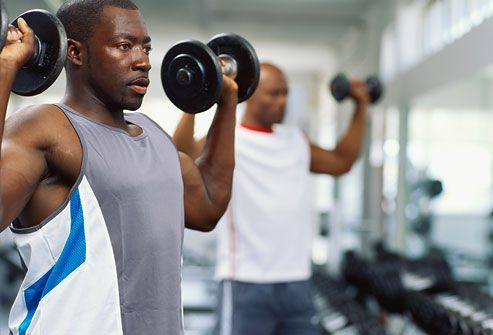
I spend a good portion of every day helping people get fitter and healthier, but the majority of my clients are women. Men seem to think they are indestructible (the younger ones) or that they know how to do it themselves (the older ones). I am actually quite pleased to have 5 or 6 male clients right now - which may be more than I have ever had at one time.
A new metastudy came out this week that reviewed quality studies from the last six years or so demonstrates the power exercise has to keep us healthy and help us heal faster if we do get sick.
What men should know about the impact of physical activity on their health
By L. Alford
Article first published online: 12 NOV 2010
DOI: 10.1111/j.1742-1241.2010.02478.x
© 2010 Blackwell Publishing Ltd
IntroductionInternational Journal of Clinical Practice
Volume 64, Issue 13, pages 1731–1734, December 2010
Length of life and quality of health depend on a complex mix of factors of individual variable weighting. Genotype, lifestyle variables, country of residence and luck all have a role to play (1,2). An individual has little control over some of these factors. Others such as the lifestyle variables – obesity, diet, physical activity levels and smoking – have at least an element of personal choice and control (1–4). The aim of this perspective was to discuss one of these variables – physical activity – in relation to the health of men. Although the focus of this study is on men the messages on physical activity are relevant to both sexes across all ages.
Although for thousands of years it has been suggested that physical activity is beneficial to health, serious scientific research into the topic has only occurred over the last 60 years (5). During this period strong evidence has accumulated to verify that physical activity is indeed good for health. Regular physical activity reduces the risks of many diseases, improves longevity and improves function and quality of life (5,6). Indeed, Church and Blair (7) claim that the beneficial effects are so great that if it could be taken in pill form it would radically alter the world as we know it. It is with certainty that all health care professionals can recommend some form of physical activity to their patients.
You can download the whole article as a PDF.
Here are some of the take-home points:
Health benefits identified by the review include:
- Regular moderate to intense physical activity is associated with decreased risk of coronary heart disease and ischaemic and haemorrhagic stroke.
- A growing body of evidence suggests that increasing physical activity can also reduce the risk of certain types of cancers, osteoporosis, type 2 diabetes, depression, obesity and high blood pressure.
- Evidence of the beneficial effects of physical activity in the primary prevention and management of cancer is growing and there is an association between higher levels of physical activity and lower cancer death rates.
- Research has found that walking or cycling for at least an half-an-hour a day is associated with a reduction in cancer and that when this is increased to an hour cancer incidence falls by 16 per cent.
- Evidence is mixed when it comes to specific cancers. Research has shown a strong relationship between increased physical activity and reduced colon cancer in both sexes. And men who are more active at work -- not just sitting at a desk -- have lower rates of prostate cancer.
- Other cancer studies show that physical activity after diagnosis can aid recovery and improve outcomes.
- Studies have also shown that men who are physically active are less likely to experience erection problems.
- There is growing evidence that physical activity could decrease the risk of dementia in the elderly.
Recommendations identified by the review include:
- Healthy adults aged between 18 and 65 should aim for 150 minutes of moderate intensity physical activity a week, such as 30 minutes of brisk walking, five days a week. And people who undertake more vigorous intensity exercise, such as jogging, should aim for 20 minutes three days a week.
- Healthy adults should aim for two strength-training sessions a week that work with the body's major muscle groups.
- Older people can benefit from exercise that helps to maintain their balance and flexibility.
- People who are physically active should continue to exercise even when they become middle aged or elderly and those who aren't should increase their physical activity.
- Not smoking and following a healthy diet is also important.
"Ideally, to gain maximum health benefits people should exercise, not smoke, eat a healthy diet and have a body mass index of less than 25" says Mr Alford. "The more of these healthy traits an individual has, the less likely they are to develop a range of chronic disorders. Even if people can't give up smoking and maintain a healthy weight, they can still gain health benefits from increasing the amount of regular exercise they take.
"Physical inactivity results in widespread pathophysiological changes to our bodies. It appears that our bodies have evolved to function optimally on a certain level of physically activity that many of us simply do not achieve in our modern, sedentary lifestyles.

No comments:
Post a Comment